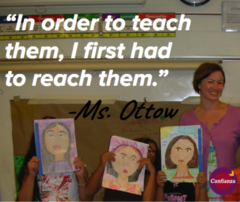Start with the End Use in Mind: Student-Centered Curriculum Design
by Sarah B. Ottow
One of my teaching mentors, Dr. Martin Haberman, told me sound advice I have never forgotten: "The most effective classroom management is a student-centered curriculum." As a former classroom teacher and English Learner specialist, I can say that nothing is truer. Whether I had thirty 6th graders in front of me, fifteen alternative high school students, or a handful of primary age students, I knew I always had to teach to who they were. I had standards-based content to teach, but in order to teach them I had to first reach them. I had to find out who they were, what they brought to the classroom and work to build bridges from their experiences to the new knowledge and skills I was charged with teaching. In other words, I had to make the curriculum function for the learner, the student, the "end user", if you will.
Now, as the founder of a consulting organization that specializes in equitable access for English Language Learners (ELLs)/multilingual learners, I keep Dr. Haberman's sage wisdom in the fore front of my mind and my heart. Not only does his advice work for school-age students but it also rings true for the educators, the adult learners, we work with everyday as well! We need to make our learning experiences as learner-centered as possible, as human-centered as can be. It all starts with relationships and teaching--or coaching--to who people are. The heart of my organization is this cultural concept of confianza -- the notion that all learning starts with mutual respect and trust. Designing curriculum and learning experiences for students is no different. If we want to keep students engaged, not just compliant, but engaged in deep learning through relevant, high complex tasks, we need to teach with them in mind. We need to teach to who our students are and find ways to connect the content to them. Project based learning can help (see our article about PBL here) as well as ensuring we are designing rigorous tasks (see our article on Depth of Knowledge here). At Confianza, we help our partner schools map and redesign curriculum with a language lens and social justice standards in mind.
We know that our language learners require two unique layers when it comes to curriculum design. First is that we need to attend to their background, their culture, their experiences, their "funds of knowledge". A sage piece of advice from Jim Cummins is that "no learner is a blank slate." We must never assume that a learner comes to us with nothing. Everyone comes with something and we need to find ways to engage with and build on competencies and assets they bring to the classroom. Second, we need to plan, teach and assess with a "language lens". This means we consider what language we are teaching of any content in any classroom and we provide scaffolds to make that language and content accessible. These two considerations that work for ELLs also work for what we like to refer to as "Academic Language Learners" or ALLs. While ELLs benefit from specific attention to their cultural perspective and their language development, ALL students can also benefit from these considerations in our increasingly diverse and global classroom communities.
See my book on how to plan, teach and assess with what we call at Confianza a “language lens” here. International orders here.
To Further Your Learning
Ottow, S. (2018). EL Formative Assessments-Language Functions. [Video file]. Retrieved from https://vimeo.com/273394913
Ottow, S. (2018, June 23). Make it Functional! Curriculum Guidance for Teachers of ELLs and ALLs. [Video file]. Retrieved from https://www.youtube.com/watch?v=hPt3N8YjSeU&feature=youtu.be
Schwartz, K. (2018, May 28). Why Teaching English Through Content Is Critical for ELL Students. [Blog Post]. Retrieved from https://www.kqed.org/mindshift/51268/why-teaching-english-through-content-is-critical-for-ell-students
The Teaching Channel. (n.d.) Deep Dive: English Language Learners. [Blog post]. Retrieved from https://www.teachingchannel.org/ells

